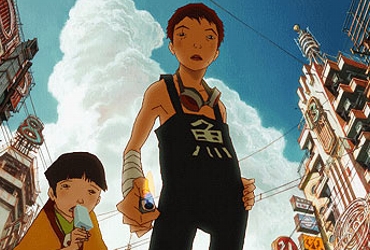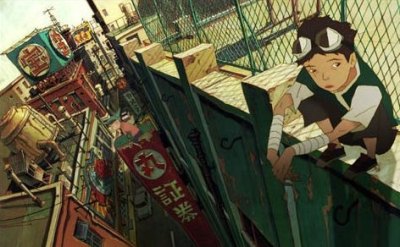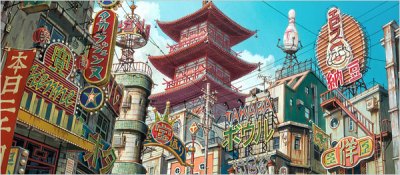| Reviews & Columns |
|
Reviews DVD TV on DVD Blu-ray 4K UHD International DVDs In Theaters Reviews by Studio Video Games Features Collector Series DVDs Easter Egg Database Interviews DVD Talk Radio Feature Articles Columns Anime Talk DVD Savant Horror DVDs The M.O.D. Squad Art House HD Talk Silent DVD
|
DVD Talk Forum |
|
|
| Resources |
|
DVD Price Search Customer Service #'s RCE Info Links |
|
Columns
|
|
|
Tekkon Kinkreet
With the animated film Tekkonkinkreet director Michael Arias became the first Westerner to create an anime feature film. Born in the US but living in Japan, Arias has an impeccable pedigree. He worked with the anime legend Hayao Miyazaki on the seminal Princess Mononoke and contributed work to The Animatrix project. For his first animated feature, he chose to adapt Taiyo Matsumoto's manga Black and White (serialized in the US in the late, lamented, magazine Pulp.) This film is a visual feast with intricately detailed backgrounds that would make wonderful paintings. Unfortunately the adaptation fails on several marks and even the endearing animation style isn't enough to overcome the problems with the script.
Treasure Town is located on an island in the middle of a river that flows through a sprawling metropolis. The whole island is the seedy side of town. It's inhabited by prostitutes, gangs, and pushers, and two orphaned kids who are trying to scrape by; Black and White. Black is older, more aggressive and street smart. White on the other hand is innocent, pure, and ignorant. Every time that Black steals or beats up someone, White prays to God and asks his forgiveness, and promises that Black will never do it again.
 Living in an old abandoned car under an overpass, Black and White are the only members of The Cats, a youth street gang and they live like any stray, taking what they can when they can. Things change when an older Yakuza member, The Rat, and his young sidekick, Kimura, move back into town. They've been instructed to take over Treasure Town, and go about systematically doing just that. They take on the local gang who runs a lot of the rackets without much trouble, but they didn't count on Black and White. As far as Black is concerned, this is his town and no one is going to change it. He seems to have the gangsters worried until Snake arrives, with his three henchmen whose only job is to remove obstacles, even if they are young kids.
Living in an old abandoned car under an overpass, Black and White are the only members of The Cats, a youth street gang and they live like any stray, taking what they can when they can. Things change when an older Yakuza member, The Rat, and his young sidekick, Kimura, move back into town. They've been instructed to take over Treasure Town, and go about systematically doing just that. They take on the local gang who runs a lot of the rackets without much trouble, but they didn't count on Black and White. As far as Black is concerned, this is his town and no one is going to change it. He seems to have the gangsters worried until Snake arrives, with his three henchmen whose only job is to remove obstacles, even if they are young kids.
The manga that this movie is based on is excellent, and I was really looking forward to seeing the film. There's a lot in this movie, both visually and thematically. Black and White are of course opposites but at the same time linked together, like the Yin and Yang. They compliment each other, and neither one is complete by themselves. Vicious Black needs the calming effect of White, and White needs Blacks abilities to survive. This duality also carries over to the other main topic of the film, the battle between old vs. new. Treasure Town is the old place where crime and corruption are a way of life, but the Yakuza that move in have noticed that it's in the middle of the most expensive real estate in the city. They want to buy it up and turn the place into an amusement park. Both the older mobster is against the idea. As he laments, many boys have turned into men in the brothels of Treasure Town. But the young men are more interested in making more money than preserving the past.
 While these themes are interesting and the plot is engaging, ultimately this project fails because of the heavily flawed script. As previously mentioned, this movie was based on a popular comic. The problem is that they didn't adapt the manga to a different medium; rather episodes from the manga were merely animated. This sounds like a small difference but it's at the heart of what is wrong with this film. It turns a long but interesting comic into a rambling and sometimes nearly incoherent movie. Ironically abbreviation of the manga looses most of the complexity of the original and yet is still choppy and disjointed.
While these themes are interesting and the plot is engaging, ultimately this project fails because of the heavily flawed script. As previously mentioned, this movie was based on a popular comic. The problem is that they didn't adapt the manga to a different medium; rather episodes from the manga were merely animated. This sounds like a small difference but it's at the heart of what is wrong with this film. It turns a long but interesting comic into a rambling and sometimes nearly incoherent movie. Ironically abbreviation of the manga looses most of the complexity of the original and yet is still choppy and disjointed.
One of the things an adaptation should do is get to the core story that is being told and focus on that. Unfortunately Anthony Weintraub, who created the script, wasn't able to do that. He didn't prune the 600 page story down to its essence, and chose to keep most of the characters and just omit several vignettes instead. This fills the picture with uninteresting and unnecessary characters whose only purpose seems to be to make the film more obtuse. What was the point of the aging police detective who wandering in and out of scenes mumbling? The old man constantly proclaiming that Treasure Town was coming to an end and occasionally spouting philosophical drivel was also extraneous. It seemed at times that the movie is going to bring all of the disparate characters together and make them meaningful, but it never does.
Another problem with the adaptation is that it was too literal. In the manga when Black grabs a metal sign bolted to a street light, pulls himself up and jumps to an awning, and from there to the top of a building, it looks like the work of an athletic and nimble person. When you animate that same move in a movie however, it makes Black look super-human with strength and dexterity well beyond mortal men, something that wasn't intended. I'd be willing to bet that more than one person thought this was a movie about superhero kids after the first 20 minutes.
Manga are also serialized (usually weekly) in Japan, with each installment running a dozen or so pages and several different stories sharing the same magazine. To get readers interested enough to buy the next installment of the story, it is common to end a chapter on a cliff-hanger. That happened in Black and White, and added to the thrill of the story. When you string these all together however, it becomes improbable and a bit silly. In the second half of the film the main characters are each fatally wounded at different times only to have a miraculous recovery. The number of times one of the kids has a gun held up to his head (or a similarly threatening move) makes viewers roll their eyes. The lack of subtlety and overemphasis on theatrics really harms the film.
 Okay, that's what's wrong with the film. There's a lot that's right with it however. Visually, the movie is a masterpiece. Against all odds Michael Arias was able to make the peculiar style of the manga translate to the screen. The backgrounds, especially the shots of Treasure Town were stunning. The urban area was made up of closely packed buildings with ancient billboards on their roofs and an eclectic mix of bizarre remnants of another age, such as the town clock that features an animatronic version of the Hindu God Ganesh. (The symbolism of using the deity who represents new beginnings is also interesting.) Dazzlingly colorful this backdrop for the movie makes the images of the film very exciting.
Okay, that's what's wrong with the film. There's a lot that's right with it however. Visually, the movie is a masterpiece. Against all odds Michael Arias was able to make the peculiar style of the manga translate to the screen. The backgrounds, especially the shots of Treasure Town were stunning. The urban area was made up of closely packed buildings with ancient billboards on their roofs and an eclectic mix of bizarre remnants of another age, such as the town clock that features an animatronic version of the Hindu God Ganesh. (The symbolism of using the deity who represents new beginnings is also interesting.) Dazzlingly colorful this backdrop for the movie makes the images of the film very exciting.
It doesn't stop there though. The characters are all drawn in a different style from the backgrounds, and the simple, child-like caricatures illustrate how Black and White view the world. It is a gutsy experiment, making the foregrounds intentionally less interesting than the backgrounds, but it works wonderfully in this picture. It brings to life the sense of wonder that children have, with a big and dazzling city to explore that is populated with ordinary and dull adults.
The climax of the movie was also a pictorial tour-de-force that really let the animators run wild. The extraordinary images were amazing to watch. This 2001: A Space Odyssey-like metaphysical ending will turn off many viewers, but animation fans will have a great time just watching this section unfold.
The Blu-ray Disc:
Video:
While the film itself had some problems, the 2.40:1 1080p transfer is fantastic. This movie really shines in high definition. It is filled with eye-popping colors and great visuals. Treasure Town is wonderfully cluttered and detailed and this disc brings out every fine line wonderfully. The lines are very tight, and though sometimes they shimmer slightly, I think this was an artistic choice and not a result of compression. There are a couple of scenes where the colors are a little blotchy. The close-up of White's face when he's freaking out near the end has colors that aren't smooth and even. Once again this could be intentional. There wasn't any aliasing, something that often plagues animation, and other common defects were also absent.
Audio:
This disc comes with the original Japanese track in both lossless 5.1 PCM and DD 5.1. For those that want to concentrate of the visuals rather than reading subtitles, there's also a DD 5.1 English dub. (Subtitles are available in English, Spanish, Portuguese, and French.) I viewed the film with the PCM track and the audio is nearly as impressive as the video. The full soundstage is used throughout the film to great effect and the imaging is spot on. When Ganesh emerges from the clock early on in the film the whole room is filled with sound, engulfing the viewer. Later when Black is fighting the super-powered goons, you can hear his footsteps from all corners of the room and he runs, jumps, and scurries away.
Spot checking the English track showed that the dub was very good. The mix was just as dynamic as the original language and the voice actors did a good job of bringing their characters to life. There weren't any fake accents or high pitched girls, though White's voice did come across as a big grating in some of the scenes that I watched. In any case these were both great sounding mixes.
Extras:
The disc comes with the same bonus features as the SD version of the film. First off there's a scene specific commentary with director Michael Arias, script writer Anthony Weintraub and sound designer Mitch Osias. This was a pretty technical commentary with a lot of information about how certain effects were achieved. It was a bit dry for my tastes, but people interested in the nuts and bolts of animation will surely enjoy it.
There are also two featurettes. The first is A Conversation with Director Michael Arias and British Music Duo Plaid which runs nearly 12 minutes and is fairly run of the mill. They talk about their past work together and how their cooperation on this film came about. The next is The Making of Tekkonkinkreet, a nearly 45 minute look behind the scenes. It was much more than your typical fluff piece. This featurette examined the problems that Arais had to overcome to get his project finished and the extensive planning that was done. It was very thorough and fairly interesting.
Final Thoughts:
If you want to show someone that anime is more than giant robots and magical girls, don't choose this movie to show them. While the images are interesting and the backgrounds gorgeous, the flawed adaptation and the metaphysical ending will turn off many mainstream viewers. That's too bad, because this is a film worth watching, warts and all. The Blu-ray disc looked and sounded fantastic too. If you're an anime fan, make a point of seeing this, you really should just for the visuals. It would make a good Rental.
Note: The images in this review are not from the Blu-ray disc and do not necessarily represent the image quality on the disc.
|
| Popular Reviews |
| Sponsored Links |
|
|
| Sponsored Links |
|
|
| Release List | Reviews | Shop | Newsletter | Forum | DVD Giveaways | Blu-Ray | Advertise |
|
Copyright 2024 DVDTalk.com All Rights Reserved. Legal Info, Privacy Policy, Terms of Use,
Manage Preferences,
Your Privacy Choices | |||||||















